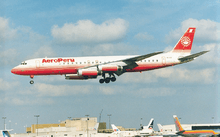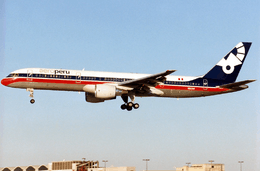Aeroperú
Empresa de Transporte Aéreo del Perú S.A., usually known as Aeroperú, was a Peruvian airline, serving as flag carrier of Peru from 1973 to 1999. The company was headquartered in Lima, with the city's Jorge Chavez International Airport serving as its hub.[2] Besides an extensive domestic route network, Aeroperú offered international flights to places in Latin America and the United States of America.[3][4] The company had around 1,500 employees.[5]
 | |||||||
| |||||||
| Founded | May 22, 1973 | ||||||
|---|---|---|---|---|---|---|---|
| Ceased operations | August 18, 1999 | ||||||
| Hubs | Jorge Chavez International Airport (1973-1999) | ||||||
| Focus cities | El Dorado International Airport (late 1990s)[1] | ||||||
| Frequent-flyer program | Club Premier | ||||||
| Parent company | Aeroméxico (1993-1999) | ||||||
| Headquarters | Lima, Peru | ||||||
| Website | www.aeroperu.com | ||||||

History
Aeroperú was formed on 22 May 1973 following the reorganization of SATCO,[2] an earlier airline founded on 1960 and controlled by the Peruvian Army. Initially a wholly state-owned company with a fleet of three Fokker F28 Fellowships taken over from SATCO, revenue flights were commenced in October on the Lima-Cusco route.[6] Soon, a Boeing 727 joined the fleet, and the airline placed an order for two new Fokker F27 Friendships.[7] In 1974, two Douglas DC-8s were acquired from Viasa, which allowed the launch of international routes.[7] The inaugural international flight to Buenos Aires took place on 29 July of that year,[6] soon followed by a scheduled service to Miami.[7] By 1978, the Aeroperú network had grown to include a multitude of destinations in Latin America, and also the US cities of New York and Los Angeles due to their large Latino populations.[4]
In July 1981, Aeroperú was gradually privatized, with the Peruvian government keeping a minority share of 20 percent.[2] In 1982, plans were made for a merger with Faucett Perú, the other large passenger airline in the country at that time. As a preparatory measure, redundancies in the route networks of the two airlines were removed, so that Aeroperú had to suspend flights to a number of destinations,[8] including Rio de Janeiro, Sao Paulo, New York City and Los Angeles.[9] No further steps were taken towards merging the two airlines, and so in 1983 flights to several destinations recommenced.[10] A bilateral air traffic agreement between Peru and the United States expired on 11 November 1983. Because of disagreements over the granting of fifth freedom rights, all flights between the two countries were suspended in May 1984[11] until mid-1985, which affected Aeroperú's Lima-Miami route.[12]
In 1993, Aeroméxico acquired 70 percent of the shares worth $54 million, thus making Aeroperú its subsidiary.[13] Subsequently two Boeing 757-200 airliners were transferred, allowing Aeroperú to replace their ageing DC-8s.[14] In 1996, 47 percent of Aeroperú was transferred to Cintra, the parent company of Aeroméxico and Mexicana de Aviación.[6] The three airlines entered mutual codeshare agreements under the Alas de Americas name,[6] with Aeroperú joining Club Permier, the frequent-flyer program of Aeroméxico. Between 1996 and 1997, Aeropéru maintained a second base at Bogotá's El Dorado International Airport in Colombia, from where regional flights were offered.[1][15] In 1998, Delta Air Lines became a major shareholder of Aeroperú, when they acquired a 35 percent stake in the airline.[2] The agreement saw Cintra reducing their share to an equal 35 percent.[16]
Due to financial difficulties that had troubled the airline for most of its existence, Aeroperú was forced to suspend all flight operations on 10 March 1999.[16] Several plans for a relaunch were made, which included a possible buy-in of Continental Airlines[17] or a takeover by a group of foreign investors.[2] None of these materialized, and Aeroperú was liquidated on 18 August 1999.[2][6] Most of its route network as well as the role of Peruvian flag carrier was taken over by newly founded LAN Perú.
Aeroperu chorus
Aeroperu boasted of a well known musical chorus, Coro de Aeroperu, consisting of a set of singers from within Aeroperu's pilots and flight attendants.[18] The chorus released two albums which also became promotional items for the airline, "El Canto del Peru para la gente de las Americas" ("Peru's songs for the people of the Americas") and "Musica en la ruta del Sol" (Music on the sun route).[19]
Destinations
With Lima Airport being its most important hub, Aeroperú maintained an extensive domestic route network. International flights were offered to a number of cities in Latin America, as well as the United States.
Fleet
Over the years, Aeroperú operated the following aircraft types (short-term leases are omitted):[2]
| Aircraft | Introduced | Retired |
|---|---|---|
| Boeing 727-100/200 | ||
| Boeing 737-200 | ||
| Boeing 757-200 | ||
| Douglas DC-8 | ||
| Douglas DC-10 | ||
| Fokker F27 Friendship | ||
| Fokker F28 Fellowship | ||
| Lockheed L-1011 TriStar[21] | 1991 |
1998 |
Accidents and incidents

- On 25 October 1988, in Aeroperú Flight 772, an Aeroperú Fokker F28 Fellowship (registered OB-R-1020) took off at Inca Manco Cápac International Airport for a domestic flight to Arequipa, but failed to obtain any substantial height. Subsequently, the aircraft hit the ground and broke up into several pieces. Of the 65 passengers on board, 11 were killed, as well as one crew member.[22]
- On 2 October 1996, 70 people died in the disaster of Flight 603. The Boeing 757-200 registered N52AW had been en route a scheduled flight from Lima to Santiago de Chile when it crashed into the Pacific Ocean at 01:11 local time. The investigation revealed that during earlier maintenance work, a protective tape covering the static ports of the airplane had not been removed, which resulted in incorrect instrument data being delivered to the pilots during the accident flight.[23]
References
- "World Airline Directory". Flight International (20 March 1996): 44. Retrieved 19 April 2013.
- "Information about Aeroperú". Aero Transport Data Bank. Retrieved 19 April 2013.
- Aeroperú timetable. Issued November 15, 1975
- "Aeroperú 1978 routemap". Retrieved 19 April 2013.
- "World Airline Directory". Flight International (25 March 1992): 34. Retrieved 19 April 2013.
- "World Airline Directory". Flight International. 21 March 2000: 55. Retrieved 19 April 2013.
- "World airlines update". Flight International (17 October 1974): 512. Retrieved 19 April 2013.
- "Peru streamlines its airlines". Flight International. 24 April 1982: 1028. Retrieved 19 April 2013.
- "World airline directory". Flight International (3 April 1982): 801. Retrieved 19 April 2013.
- "World Airline Directory". Flight International (2 April 1983): 870. Retrieved 19 April 2013.
- "US/Peru dispute upsets tourism". Flight International (26 January 1985): 32. Retrieved 19 April 2013.
- "World Airline Directory" (30 March 1985): 32. Retrieved 19 April 2013. Cite journal requires
|journal=(help) - "AeroMexico wins AeroPeru re-bid". Flight International (27 January 1993): 21. Retrieved 19 April 2013.
- "Aeroperú fleet list". planespotters.net. Retrieved 19 April 2013.
- "World Airline Directory". Flight International (19 March 1997): 43. Retrieved 19 April 2013.
- "AeroPerú suspends flights while debt renegotiations take place". Flight International. 17 March 1999: 20. Retrieved 19 April 2013.
- "Aeroperú stake". Flight International. 9 June 1999: 9. Retrieved 19 April 2013.
- http://www.mtv.com/artists/coro-aeroperu/
- http://www.musicstack.com/item/57567542
- "Information about Aeroperú". rzjets.net. Retrieved 19 April 2013.
- "Aeroperú fleet list". airfleets.net. Retrieved 19 April 2013.
- "Accident Description of the Aeroperú 1988 crash". Aviation Safety Network. Retrieved 19 April 2013.
- "Accident Description of Aeroperú Flight 603". Aviation Safety Network. Retrieved 19 April 2013.
External links
- (in Spanish and English) Aeroperú website (archives)
- (in Spanish) older Aeroperú domain (archives)
- (in Spanish) Castillo Maza, Juan. "EVALUACIÓN DEL PROCESO DE PRIVATIZACIÓN DE LAS EMPRESA DE SERVICIOS PÚBLICOS 1991-2000." Gestión en el Tercer Milenio. National University of San Marcos Faculty of Administrative Sciences. Year 5, #9, October 2002. (Bibliography) - ISSN 1728-2969 (electronic version). Includes an abstract in English.